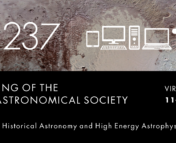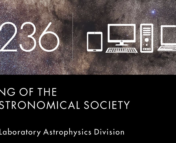In this series of posts, we sit down with a few of the keynote speakers of the 238th AAS meeting to learn more about them and their research. You can see a full schedule of their talks here, and read our other interviews here!
Betelgeuse, Betelgeuse, Betelgeuse

Prof. Emily Levesque is a massive star who loves to study massive stars. “My research now is broadly on how massive stars evolve and die. So I’m interested in the late post-main sequence phases of massive star evolution, the physics that dictate their evolution, and then what ultimately winds up happening to them when they undergo core-collapse. This involves everything from looking at … how binaries or rotation or mass loss affect their evolution to what kinds of end products you get.” It’s no surprise, then, that her Newton Lacy Pierce Prize Plenary talk will be on Betelgeuse, sort of. Prof. Levesque explains, “It’s using Betelgeuse and the great dimming that happened… around 2019 – 2020 […] and the sort of sleuthing we all wound up doing to explain the event to highlight some of the big questions that we still have about red supergiants, so stars like Betelgeuse. The talk focuses on red supergiants, but someone could swap in luminous blue variables or yellow supergiants or Wolf-Rayet stars and give a very similar talk, because there’s some really common underlying questions […] like how they lose mass, what their binary fraction (or the fraction of red supergiants in a binary system) is and how that matters, [and] how they vary. So it’ll be using Betelgeuse as kinda the archetype and then exploring what we know about evolved massive stars.”
TZO?
In addition to being granted a plenary talk, with the Newton Lacy Pierce Prize, Dr. Levesque was given what she calls a “meeting in a meeting.” The topic of this mini-meeting? Thorne–Żytkow objects (or TZOs). “So TZOs are this really interesting currently still theoretical class of star where you have something that outwardly looks like a red supergiant but its core, instead of being a normal helium fusing core, is actually a neutron star! […] Kip Thorne and Anna Żytkow predicted these back in the 1970s, and for like 40 years they were a theoretical type of star and people would occasionally try to model them again or try to search for them and didn’t have a lot of luck and Anna Żytkow got in touch with Phil Massey and I […] to ask us [if we had] ever thought about looking for these.” So the three of them put together an observing campaign to look for TZOs!
“[TZOs] they’re almost impossible to ID. They should outwardly look like normal red supergiants, but the one observational signature that people had been able to predict were these strange element signatures in their atmospheres. […] we thought that we were just doing baseline research we thought well no one knows how much molybdenum is in a normal red supergiant, so we’ll measure a bunch of normal ones; we’ll get some base levels and then maybe eventually one day someone will find one, and to our utter shock, one of the stars in our list wound up matching the abundance profile that you would expect for a TZO! So we had found to date the most compelling candidate for a TZO. In the years since, they’ve really sparked people’s curiosity […] I just had a paper come out with Lindsay DeMarchi […] looking at the GW signatures of TZOs. I’ve had people ask me, can these possibly be stable, can we try modelling them, how do they form? So there’s a lot of curiosity. […] They’re very cool, but they’re very wacky, and it’s the sort of thing where if I submitted a proposal to the IAU for a symposium on these, it’d probably get turned down b/c it’s too niche. But I was given a meeting and I could make it on whatever I wanted so I figured alright we’re doing TZOs.” In describing the schedule of this mini-meeting, Dr. Levesque mentions excitedly that Kip Thorne & Anna Żytkow will be giving the opening and closing talks, respectively. She concludes, “TZOs are definitely the wackiest, coolest thing that I’ve gotten involved with studying, and it just works out well that they’ll also be a focus of this meeting in a meeting at the AAS.”
Massive Star on the Stage
When I asked Prof. Levesque why she wanted to become an astronomer, she immediately mentions Halley’s Comet. “[…] Halley’s comet made a flyby of Earth and my big brother was studying it for a school project, so our whole family went out into the backyard […] from then on my answer, when people would ask me what I wanted to be when I grew up, was oh I want to be ballerina or an astronomer […] then later on a violinist or an astronomer and astronomer just stuck.” She went on to comment about how, when getting to college, she “realized that it was gonna be harder to do astronomy as a hobby than to do violin as a hobby, and I wanted to be at the level that people were making exciting discoveries.” I commented that I too made a decision like this when starting undergrad, musical theatre or astrophysics? Dr. Levesque excitedly said “I was a theatre kid too! I was thinking about this today because I was working on my [Newton Lacy] Pierce Prize talk that there are skills of theatre and performance and showmanship that are really important in astronomy! It helps you give a good presentation. It helps you figure out how to tell a good story which works well in a research paper [and] works well in a grant. When you’re giving a talk, even little details, like making sure an audience is engaged and following along with you [are important]. I’ve been able to use some of [my] music and performance skills in ways that I hadn’t expected!”
Comments to Current Students
Prof. Levesque pauses before immediately answering my request for advice to our student readers. “I definitely remember the anxiety around really desperately wanting to work in this field that I loved but not knowing if I would get a job and not knowing if this field would keep me. […] It’s hard to offer reassurance because we all know that the statistics are simply difficult, but one thing I wound up trying to do with myself regularly was checking in every couple years going like am I happy with what I’m doing? Am I happy with how things are going? What do I like about the job and how do I get to keep what I like? […] It’s sort of identifying what you truly love and what truly makes you tick about the job and figuring out how to follow that.” She continues, “Another thing I found helpful was having multiple mentors and multiple advisors and just having different people I could go to for feedback and advice. This could be as simple as one person is at a conference and you need a signature […] or as involved as there are people at different career stages and different types of institutions who do very different types of research […] they will all have different perspectives on the field and different advice. And getting a lot of different advice is really helpful in terms of turning it into a synthesized plan.”
To learn more about Betelgeuse, TZOs, & about massive stars tune into Dr. Levesque’s Plenary Lecture at 5:50 PM ET on Monday, June 7 at #AAS238!
Edited by: Ellis Avallone
Featured Image Credit: AAS



